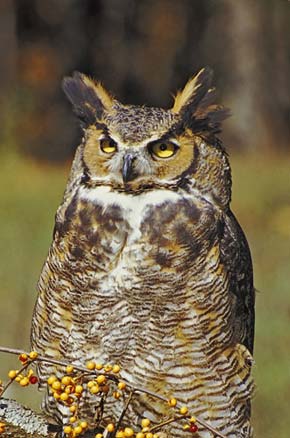
Copyright 2007 Mike Goldstein
The position of the sun, shining down on this great horned owl, has resulted in the top half of each eye being obscured by shadow. If flash was used to fill in these shadows completely, the rest of the owl would have been over-exposed.
I’m standing in a grassy field in early January. I’m dressed in my goose-down jacket, waterproof boots and pants, and I’ve protected my ears. My camera is covered, as well, because the precipitation is changing back and forth between rain and sleet. The sky is dark, the light subdued–perfect weather for photographing birds.
In front of me (and a dozen other photographers!) is a “stand” made from a tree stump and surrounded by red and gold berries. Occupying this throne is the first great horned owl I’ve ever seen. He’s in no hurry to go anywhere and pleased to pose. (Good thing I’ve brought lots of
film!)
We’re the guests of the Howell Conference and Nature Center, which is owned and operated by the Presbytery of Detroit, Michigan, and includes in its mission “…demonstrating care and stewardship by rehabilitating approximately 2,000 birds and mammals each year.“ To augment their funding and to help educate the public, the Centre periodically invites the public to photograph their charges. I’ve driven down from Toronto to participate in this “bird shoot,” joining friends from one of the Detroit camera clubs.
Until today, I’ve seen only two owls in my lifetime–a sowhet owl that turned up one day on the Toronto waterfront (I didn’t have a camera with me!), and a barred owl, a refugee from our Far North, who appeared in a local park for several weeks last winter, a bird with no sympathy whatsoever for pursuing photographers. However, today, I’m able to photograph the great horned owl in a superb setting, as well as a screech owl, a short-eared owl, barred owl and even a snowy owl. Also available as subjects are a huge red-tailed hawk and a turkey vulture.
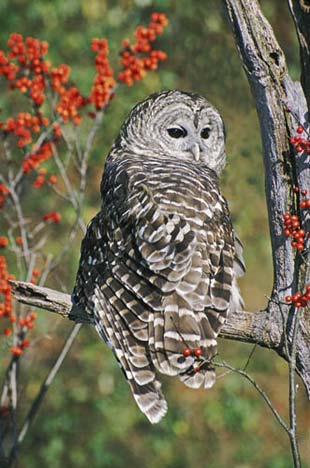
Copyright 2007 Mike Goldstein
This composition of a barred owl is very dynamic, as the bird has turned its head to look back over its shoulder. The tail, wing, and head have produced a lovely s-shaped leading line, that draws the eye into the image.
It was really fortuitous that the bird is framed by the left-facing curve of the perch on the right side, and the right-facing curve of the branch and its berries, on the left side. There really is a God of photographers!
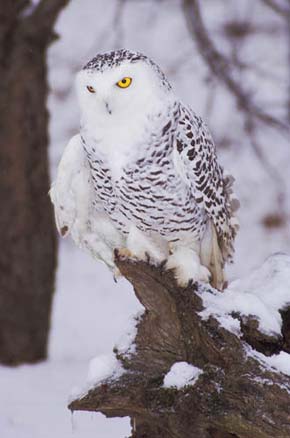
Copyright 2007 Mike Goldstein
It’s easy to see how these snowy owls blend with their backgrounds, a necessity for a large raptor such as this.
The head, with those large golden eyes that immediately draw attention, is positioned exactly at the upper intersection of thirds of the image frame. The tree trunk at the left side is unfortunate, but it wasn’t possible to shoot the bird from such an angle as to eliminate it, due to other undesirable intrusions to the right.
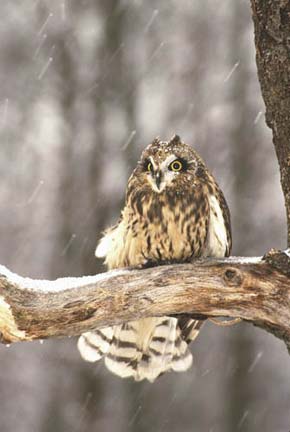
Copyright 2007 Mike Goldstein
This short-eared owl is well framed by its perch, and separated from the background woods by selective focus. An effort was made to avoid having one of the background tree trunks seem to “grow out” from the bird’s head. The tree trunk at the right side seems to anchor the bird and its perch.
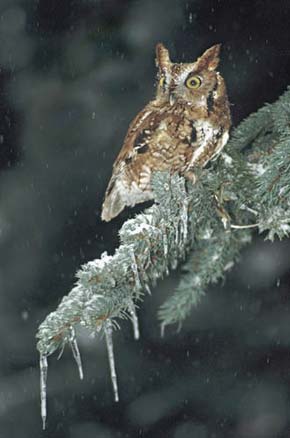
Copyright 2007 Mike Goldstein
This screech owl is ideally positioned in the frame, occupying the upper “intersection of thirds”, with its eyes looking into the frame. Both bird and branch create a nice diagonal in the frame, making a dynamic composition.
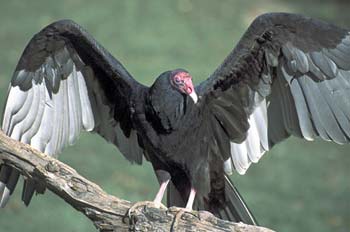
Copyright 2007 Mike Goldstein
This turkey vulture was the star of the show, the most active bird the Center seems to have.
He was constantly in motion, displaying his wings, changing position, turning his head and his body. He knew what he was there for!
I had often seen vultures flying overhead, distinctive with the white lining of the bottom of their wings, but never up so close.
This image was cropped to clip the ends of the wings on both sides, as the original had only one wing clipped.
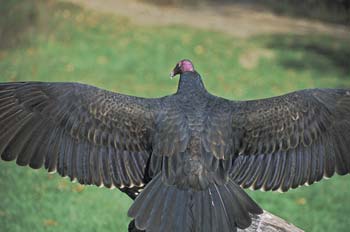
Copyright 2007 Mike Goldstein
This is a great southern exposure of a turkey vulture looking north. Since the objective is to make bird portraits, rear views are not very desirable.
Each of these creatures sits on its individual perch, changes its position from time to time, and can be coaxed by its handler to “look over here,” depending on the needs of the photographers. From time to time, the handlers interchange birds on the various stands so we can make a variety of images. Also, some birds are better suited to certain perches than others.
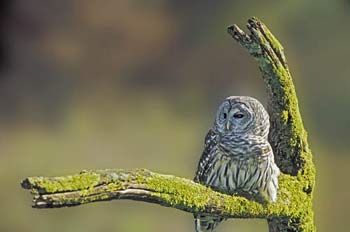
Copyright 2007 Mike Goldstein~
This image of a resting barred owl is quite stark, which contributes to its success. The perch makes a perfect frame – the bird occupies the intersection of thirds in the frame, and is looking into the frame. Too bad I clipped off the bottom of the tail, just a tad! ~
The stands are located well away from the surrounding woods, making it quite easy to “separate” the bird and its stand from the background by using a minimum depth-of-field. Using selective depth-of-focus makes the bird appear to “jump out of the frame.” One problem I notice, however, is that the various stands have been made more colorful with berry bushes, and the birds often merge with these bits of surrounding background. It’s a game of patience to wait to shoot until the bird changes its position away from the intruding vegetation, but waiting saves a lot of subsequent editing work on the computer.
I’m using a 70-300mm zoom telephoto lens, which seems to be ideal for the job. A shorter focal length would require me to move closer to the birds, which might disturb them. It would certainly disturb my fellow photographers, who would find me in their frames! The birds often spread their wings or turn around on their perches, and it’s easier to shorten the zoom than to shift position. Good nature photography demands that you not “clip off” bits of the subject with the image frame.
Modern auto focus makes this kind of photography much easier. Using “back button” focus control means I won’t be forced to re-focus each time I depress the shutter release button after changing my composition or when the bird has moved slightly.
A polarizing filter on the front of the lens reduces or eliminates bright reflections on leaves in the background woods. On bright sunny days, these reflections can cause the de-focused leaves to appear almost like round “doughnuts” in the background, an effect similar to the ones caused by mirror lenses.
I’m using a tripod, not only for sharper shots, but also to permit me to hold my flash on an extension cable over my camera while I’m using a shutter-release cable to fire the camera. A flash is useful for filling in shadows on a bright day and providing those necessary highlights in the eyes on a dark day.
I’ve already discovered that using on-camera flash will cause “red-eye” in my bird photos. The flash is set for -1 f-stop of compensation, so that whatever the ambient light might be, the flash provides less light. One hazard, of course, is that on bright days, I might end up with two highlights in the eyes, but the effort required for me to fill in those dark shadows is worth it. No doubt about it; dark days provide the perfect light for this kind of photography. On sunny days, birds like owls (nocturnal creatures) tend to squint a lot, and you get dark shadows cast by the sun on those wonderful yellow eyes.
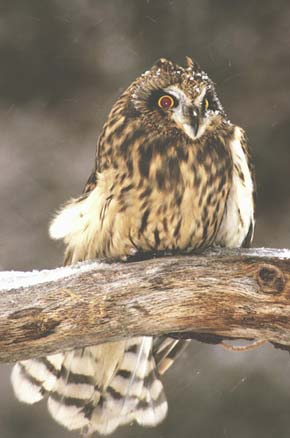
Copyright 2007 Mike Goldstein
Firing on-camera flash at this short-eared owl, with its huge eyes, has resulted in the dreaded “red-eye” phenomenon. This can be fixed with subsequent computer editing, but it’s easier to just move the flash away from the camera, connecting the two with a dedicated cable.
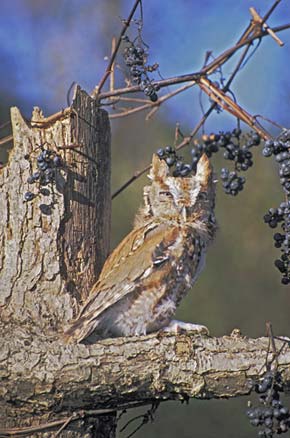
Copyright 2007 Mike Goldstein
The design of this perch is rather unfortunate, in that the small screech owl is merging with the surrounding vegetation. Even selective focus won’t fix the problem, as the background is too close to the perch. Positioning a larger bird on this perch would be more successful.
A less obvious problem is that this particular bird is almost exactly the same colour, and tone, as the perch on which it is standing – a great example of camouflage, but not so good as a photograph.
A front-lit bird, with a dark forest behind it, represents an exposure problem, as well, so I don’t depend on auto-exposure with matrix metering to produce great exposures under these conditions. I spot-meter on the birds, or some middle-toned area, and lock my exposure. (Beware of changes in the lighting when you’re doing this.) However, black turkey vultures represent the opposite exposure problem and metering on the bird in this case will result in disaster.
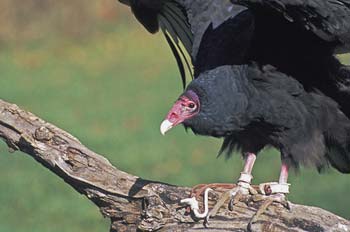
Copyright 2007 Mike Goldstein
It’s easy to see that this turkey vulture isn’t going to leave in a hurry, as the jesses securing it to the perch are obviously visible. This vulture was the most active of the bird subjects, constantly changing position, and kept its handler very busy trying to hide the jesses, to enable good “nature” photography.
One of the common hazards of photographing captive birds is that they have to be secured to the perch with ropes and rings called “jesses.” For images that can’t show the “hand of man,” it’s necessary that the viewer doesn’t see the jesses. The bird’s feathers will often hide them, but if they become visible, a quick call to the handler results in a quick “reconfiguration.” In addition, I avoid “tushy” shots. My goal is to make portraits of birds, and rear views of tail feathers just don’t cut it.
The handlers, by the way, seem very fond of their birds and work well with them. The priority is always the bird’s comfort, not the photographers’, and if the creature becomes distressed, that part of the shoot stops at once.
This kind of photography is all grab-shooting, where you wait for a good position, the right angle of the head, a change in the light, and then shoot, shoot, shoot! In three hours, I’ve exposed six rolls of film, and I’m sure the digital cameras have produced a thousand frames. The birds are tired, the handlers are packing up, and it’s time to go home. If I get several dozen good images from this day’s effort, I’ll be happy.
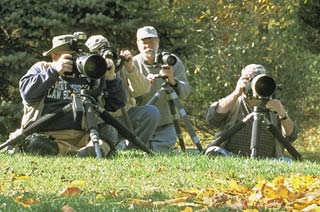
Copyright 2007 Mike Goldstein
These bird shoots attract a lot of SERIOUS photographers, who come with a variety of big glass, to blur those backgrounds and bring home the birds …
Learn some photography techniques on how to take good bird photos (with my apologies to Arthur Morris).
More photo do’s and don’ts…
by Michael Goldstein

Leave a Reply